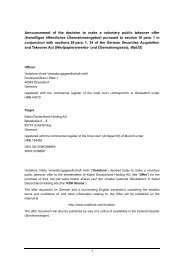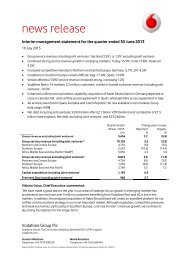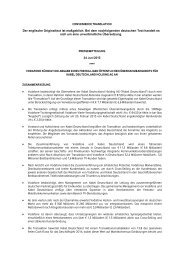You also want an ePaper? Increase the reach of your titles
YUMPU automatically turns print PDFs into web optimized ePapers that Google loves.
Moving the debate forward • The Policy Paper Series • Number 8 • April 2008<br />
CUG towards a <strong>Vodafone</strong> number, and calls to and from other<br />
mobile and fixed networks. The mobile VPN also includes,<br />
as part of the integrated service offering, fixed to mobile and<br />
mobile to fixed calls to the customer’s premises, as well as the<br />
usual mobile services.<br />
It must be emphasized that VPNs are complex products.<br />
They include not only a variety of call types but also a set of<br />
functionalities which improve the performance of corporate<br />
telecommunications networks. These features are highly<br />
demanded by corporate customers and include private<br />
numbering plans (ie. short-code dialling), users’ profiles<br />
(with permission and barring), and hierarchical functionality<br />
and billing, among others.<br />
VPNs may or may not include a direct link between the<br />
customer’s PBX and the mobile network. When there is no<br />
fixed link, calls from a customer desk phone are generated as<br />
mobile calls through a mobile traffic concentrator connected<br />
to the corporate PBX. What is important to realize is that the<br />
product is fundamentally a bundle of services, including a<br />
variety of calls and value added offerings, and does not target<br />
specifically the fixed-to-mobile market or any other narrowly<br />
defined type of service.<br />
Another key characteristic of these services is that the<br />
operators can only provide them to corporate users with<br />
closed user groups comprising a minimum number of users<br />
(handsets). This is not surprising, since the upfront and fixed<br />
costs of virtual networks imply that the service is not viable<br />
commercially unless a large volume of usage is achieved.<br />
As usual in telecoms, low per unit prices can only be provided<br />
to heavy users, when average costs are also low. This is the<br />
case in general, but more specifically for VPNs, since these<br />
products involve important upfront investments tailored to<br />
each particular corporate network.<br />
In accordance to its basic economics, the pricing of MVPNs<br />
has been traditionally based on a combination of one-time<br />
upfront fees, fixed monthly fees and a set of per minute call<br />
charges for some, but not necessarily all, of the services<br />
offered. Nevertheless, strong competitive pressures have<br />
led to the gradual erosion of upfront and monthly fees.<br />
3. The alleged practice<br />
The alleged practice of <strong>Vodafone</strong> is to charge for mobile call<br />
termination in a business product (Virtual Private Networks)<br />
a per minute price which is below the termination price<br />
charged to operators in the wholesale market. This pricing<br />
practice is alleged to amount to a price squeeze which may<br />
exclude rivals in a downstream or related market. The market<br />
allegedly foreclosed in this way is the “market” for fixed to<br />
mobile calls for business users.<br />
The basis for the allegation of a price squeeze is that operators<br />
seeking to offer a similar business service would need to buy<br />
a wholesale input (namely, mobile call termination in the<br />
<strong>Vodafone</strong> network), for which they face a wholesale price<br />
above the retail price and this places them at a competitive<br />
disadvantage in the downstream “market”.<br />
On-net Pricing in Mobile<br />
4. The observed market behaviour<br />
Voice telephony services are provided by both mobile<br />
network operators and fixed network operators, and one may<br />
consider the extent to which mobile and fixed telephony are<br />
increasingly being considered as substitutes by consumers.<br />
In fact, the overall voice market has been growing substantially<br />
in volume (10% in minutes in 2002). It is indeed true that<br />
the share of the usage served by fixed operators has been<br />
declining (in minutes from 79% in 2000 to 72% in 2002),<br />
with a corresponding increase in the share of voice minutes<br />
served by mobile networks. However, despite the fact that<br />
the mobile market grew faster in terms of minutes by 27%<br />
in 2002, volumes in the fixed market have been still growing<br />
(5% in 2002), and it appears that the growth in mobile is still<br />
principally incremental minutes rather than substitution.<br />
Revenues per minute dropped by 7% in fixed telephony both<br />
for 2001 and 2002, which is less than the decline observed in<br />
the mobile market (8% in 2001 and 12% in 2002). The evolution<br />
of competition within the fixed telephony market led also<br />
some time ago to the introduction of so-called fixed virtual<br />
private networks (FVPNs).<br />
As the mobile and fixed markets start to converge, mobile and<br />
fixed operators may have an interest in supplying comparable<br />
services, even if, as argued before, the products so far have<br />
been complementary. If intermodal competition develops,<br />
mobile operators will be obliged to lease or own fixed assets,<br />
in order to replicate the offers of fixed network operators and,<br />
similarly, fixed network operators may have to own mobile<br />
networks in order to be able to supply a very comprehensive<br />
service. Indeed, fixed operators may participate in the<br />
provision of mobile services through affiliated mobile<br />
companies, ie Telefonica with Telefónica Móviles and Auna<br />
with Amena, or through joint product offering, 3 eg <strong>Vodafone</strong>’s<br />
alliances with BT, NeoSky, Telecable Asturias, Retecal and<br />
Comunitel. Alternatively, even with mobile-fixed convergence,<br />
each type of operator may decide to exploit the competitive<br />
advantage provided by the assets it owns. Mobile operators<br />
could decide, for example, to provide low on-net call charges,<br />
while fixed operators could offer corporate clients very<br />
competitive rates for fixed high capacity connectivity<br />
between several company sites.<br />
Each of the platforms offers a different and non-coincidental<br />
set of services, combining to varying degrees mobile<br />
telephony, fixed telephony, internet access and broadcasting.<br />
There may be varying degrees of intra-platform competition<br />
(and, in this regard, mobile operators register a substantial<br />
degree of rivalry compared to other platforms), but more<br />
fundamentally it will be increasingly the case that rivalry<br />
takes place across platforms.<br />
The offerings of the different platforms are determined by<br />
technological capabilities, the business model adopted by<br />
companies, and to a certain degree by the existing regulatory<br />
framework, which can never be entirely neutral. However, and<br />
more importantly, each platform provides a different value<br />
proposition to its customers according to customer demand.<br />
In doing so, each competitor – whether fixed or mobile –<br />
chooses different pricing strategies for its bundle of services,<br />
7

















